As your awareness of your body grows more subtle, you may notice that your head is not really where you thought it was, namely balancing on top of your spine. This postural misalignment is called hyperkyphosis/head forward position. To address this problem, you need to focus on opening the front of the chest and strengthening the upper back. Equally important, however, is learning to let go of neck tension, because neck tension and hyperkyphosis mutually reinforce each other in a vicious cycle, while also contributing to chronic stress and depression.
An overly rounded upper back combined with a forward head position is not simply an aesthetic issue, and is no longer something only affecting older people. Once hyperkyphosis sets in, it tends to worsen inexorably over time. Hyperkyphosis leads to a host of health problems, including neck and shoulder pain, migraines, chronic stress, shortness of breath (which in turn increases risk of cardiovascular and lung disease and type 2 diabetes), anxiety and depression, and ultimately, to a greater risk of death. (One study found up to a shocking 44% greater risk of death, report Terry and Eva Norlyk Smith on yogauonline.com.)
How does all this happen?
Your head weighs about 10-12 pounds (4.5-5.5 kg). If it is balanced on top of your spine, that is how much pressure it exerts. When it is stacked on top of your spine, the cervical vertebrae can easily hold up that weight. The neck muscles only need to maintain the vertical alignment that allows the neck bones to do the heavy work. But for each inch (2.5 cm) that your head moves forward of its neutral location, an additional 10 pounds of force is exerted on your neck muscles, your spine, and your chest cavity.
Basically the farther forward your head, the greater its leverage and thus the greater the force exerted. Since this misalignment occurs gradually, we don’t really notice the additional pressure or the resulting rounding of the back. As the rounding of the back increases, the head tilts farther and farther downward. In order to look straight ahead, we end up tilting the head back on top of the spine because that requires less physical and mental effort than to correct the rounding of the upper back. Tilting the head back in turn leads to chronically tight and painful neck extensors. A tight neck in turn is one of the most common complaints people have about their body, and contributes to a host of other health problems.
Why haven’t you heard about this?
Until recently hyperkyphosis was assumed to be a side-effect of osteoporosis, which is already recognized as a major health issue. But it now appears that hyperkyphosis is unrelated to osteoporosis in two thirds of cases, and may actually be a greater health risk than osteoporosis.
What can you do about it? Change your computer usage
Make sure that your computer screen’s top edge is level with your eyes or slightly higher. This is extremely important if you spend a lot of time in front of the computer. If you have a laptop, that means buying an external keyboard and mouse and placing your laptop on a box (or a special laptop stand) on top of your desk to bring the screen high enough. Also make taking frequent breaks a priority, during which you consciously realign your spine towards its natural double S-curve by allowing your breastbone and the back of your head to float up. I’ll show you some easy stretches you can do when you take your tea or pee breaks.
What can you do about it? Change your tablet and phone usage
Reduce the amount of time you spend on tablets and smart phones, because any device that forces you to touch the screen to interact with it is going to wreak havoc on your posture. If you do use smart phones and tablets a lot, make sure that you hold the device relatively high for reading. The same, of course, goes for paper books and magazines. If you do a lot of typing on your tablet or phone, and thus need to place it lower, make sure that you look at the device by looking down past your nose while keeping your spine relatively neutral. Even better, buy a Bluetooth keyboard for your tablet or phone, and place the screen on a stand on top of a box. Those tablet covers with a built-in keyboard are just as bad for your posture as a laptop without an external keyboard.
However, I would argue that it’s not the heavy mobile device usage that is the main problem. Instead it’s the fact that we don’t realign our spine once we slip the smartphone back into our pocket. When we put the phone away, we simply tilt the head back to horizontal, maintaining the hunchback we created when we started using the phone. The neck tension required to tilt the head back to horizontal actually increases the collapse of the upper back and sets a vicious cycle in motion. The more rounded your back is, the more you need to tense your neck to look forward. But the more you tense your neck, the more the upper back rounds, through a reflex called reciprocal inhibition.
What can you do about it? Yoga
There are several ways to approach this issue in your yoga practice that we will focus on this week. Building body awareness to help you notice poor posture is an extremely important first step, because if you don’t know there is an issue with your posture then you can’t even begin to address it.
Any longterm change in posture results in some muscles tightening and shortening because they are working overtime, while the opposing muscles are growing weaker from disuse through reciprocal inhibition. In addition, connective tissue on the side towards which the spine is bending ends up being slack all the time and as a result tightens up, while connective tissue on the other side is gradually getting overstretched.
Moving back towards a more neutral posture thus involves stretching the tissues that have gotten tight, strengthening muscles that have grown weak, and relaxing chronically contracted muscles. Thus reversing hyperkyphosis involves three main practices.
- Stretching out the front of the thoracic spine and the front of the rib cage.
- Strengthening the musculature of the middle and upper back which progressively weakens with hyperkyphosis.
- Relaxing the back of the neck.
The lengthening of the front of the chest can be accomplished through passive backbends of the upper spine, while the strengthening of the upper back muscles is best achieved through emphasizing the arching of the upper back in gentle active backbends like Bridge and Locust Pose. We have been focusing on both for the last few weeks.
Letting go of neck tension
The relaxation of the back of the neck is our focus this week. It is an act of undoing that you can practice in every yoga pose. To learn how, read the next few paragraphs.
Leading with the chin and the gaze (in your daily life and in your yoga practice) is one of the main contributing factors to hyperkyphosis, because sticking your chin out (and looking up) tightens the muscles at the back of the neck. Tight neck muscles in turn inhibit and thus chronically weaken the muscles of the middle back, as mentioned above. And it is the middle back muscles that you need to activate to reduce the over-rounding of the upper back and the collapsing of the chest.
Learning to move from the core instead of the chin or gaze is thus one of the most powerful things you can learn to improve your posture, and your overall wellbeing. Unfortunately, most yogis lead with their chin or gaze, and plenty of standard yoga instructions actively encourage it. This week we will focus on making our practice smarter than our habits so that we can maximize the benefits of that practice.
Try it now: Measure your hyperkyphosis
There is an easy way to check whether you have hyperkyphosis. Stand a few centimeters in front of a smooth wall, close your eyes, and assume your typical posture. Then shuffle your feet backwards until your buttocks and your upper back just touch the wall. Is the back of your head touching the wall as well? If so, you are among a tiny percentage of people with relatively neutral posture. If not, you have hyperkyphosis/head forward position. (Depending on head shape, up to 1 cm of space between the wall and the back of the head may be neutral for some people).
The greater the distance between the back of the head and the wall, the more advanced the hyperkyphosis. Try moving your head towards the wall, and you will notice that you end up tilting your head back on top of the spine to move it to the wall. In case the resulting increased neck tension doesn’t make it obvious, this is not the solution to the problem!
Try it now: Practice undoing the neck tension
However, tilting the head farther back may help you find the solution by fatiguing the muscles you need to learn to relax, and thus facilitating that relaxation. Tilt your head so far back on top of the spine that your shoulder blades come away from the wall (while keeping your buttocks at the wall). Observe for a breath or two how unpleasant this increased neck tension feels. Then on an inhale slowly and deliciously allow your head to slide up the wall (maintaining contact between head and wall throughout) while simultaneously allowing your shoulder blades to roll down the back. I consciously say “allow the head to slide” rather than “slide the head”, because in order to do this movement most effectively, you have to do it with a minimum of effort to emphasize the relaxation of muscles whose contraction is preventing the movement.
If you can feel muscles contracting in the front of the throat, then you are using the wrong muscles. Contracting the throat muscles will not actually relax the back of the neck. The action should feel effortless, because the muscles you need to contract are so deep inside your neck that they lack the sensors that tell you that they are contracting. The muscles to use are called the deep neck flexors.
How it works
The muscles that take the shoulder blades down the back, by the way, also reciprocally inhibit the neck extensors. Thus this shoulder blade action also contributes to the relaxation of the neck. At the same time, the contraction of the middle back muscles and of the deep neck flexors rearrange the upper spine towards a vertically aligned, gentle S-curve. This in turn means that the neck extensors don’t have to grip any more because the head is once again balanced on top of the spine. (Note that if you have strong head forward position, this exercise will not feel effortless at first, because the tightness of soft tissue in the chest is actually inhibiting this realignment. In this case, emphasize passive stretches of the front of the chest and shoulders for now.)
Sliding the head up the wall is a very challenging exercise for many, but it is incredibly worthwhile. It is challenging because it requires you to engage muscles that you didn’t even know you had. If you find the action very challenging, hyperextend your neck more strongly before you begin sliding the head up the wall. Hold this strong contraction for a few breaths in order to fatigue the muscles you are trying to relax in the next step. (However, if such a strong contraction of the neck feels very uncomfortable or even painful, then ease off immediately.)
Sliding the head up the wall should feel positively marvelous. If it doesn’t, you are using the wrong muscles. Don’t concentrate on the muscles you need to contract, because some of them you can’t feel anyway. Instead focus on the desired results, relaxing the back of the neck by increasing the distance between the back of the head and the shoulder blades.
Make neck lengthening part of every pose
Once this movement becomes second nature, you will want to incorporate it in any yoga pose in which you feel excessive neck tension. You will also want to employ it in any pose in which you find yourself leading with your chin. Such poses will probably includes backbends, forward bends and folds, and spinal twists. They will also include any pose that feels physically challenging, like arm balances and inversions. Physically challenging poses encourage neck tension because the tension triggers the stress response. The one positive effect of being in stress mode is that you can contract your muscles with more force. However, stressing yourself out just to come into Crow pose is the wrong compromise, as you then merely use your yoga practice to reinforce the detrimental habits that you are already practicing all day long.
PS: For more information on neck tension and why it matters, see my Neck Tension video on youtube.

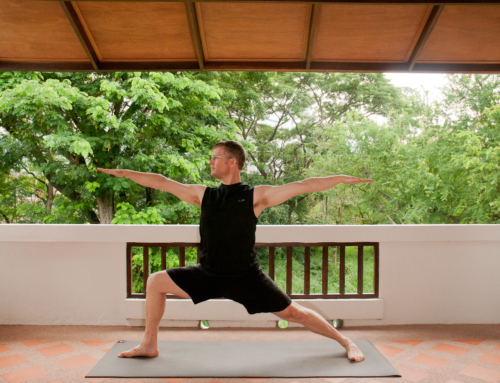
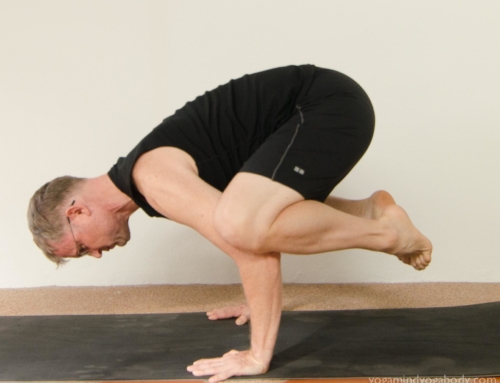
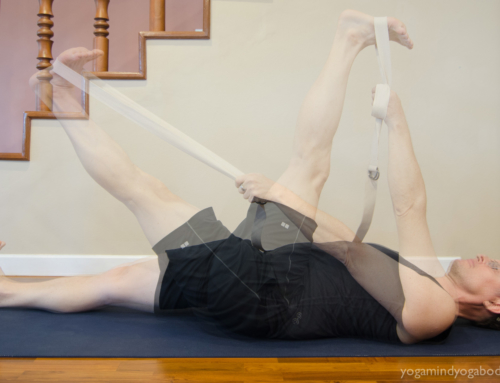
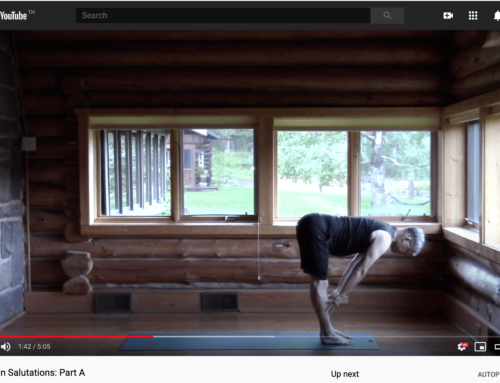
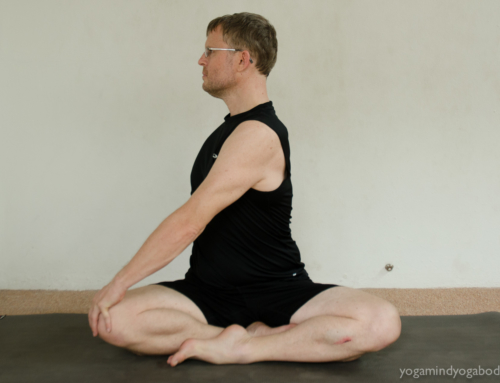
Leave A Comment